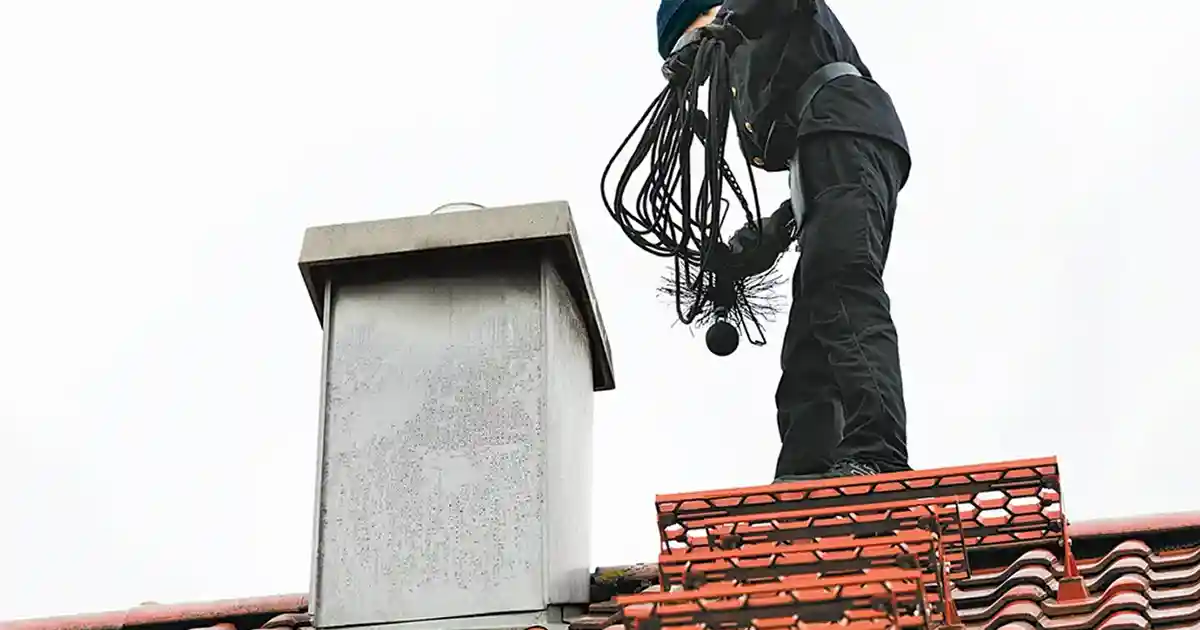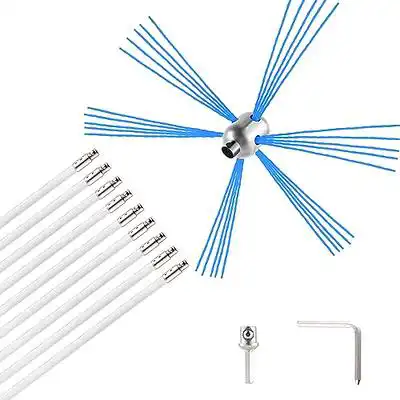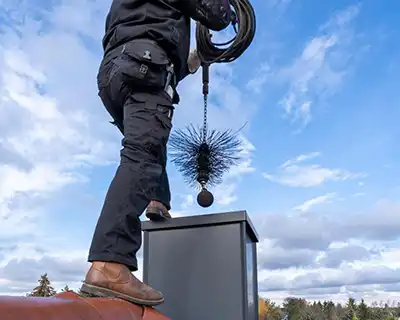
Chimney sweeping may seem like an old-fashioned trade, but it’s as vital today as it was in the past. Whether you use a wood-burning stove or a fireplace, ensuring your chimney is clean and free of obstructions is crucial for your home's safety. Without regular cleaning, soot and creosote can accumulate, leading to hazardous conditions such as chimney fires and dangerous gases like carbon monoxide entering your home.
Chimney sweeps are professionals trained to clean these vital structures, ensuring they function efficiently and safely. In addition to clearing out soot and debris, they inspect the flue for any structural issues, blockages, or damage that could compromise your safety. Chimney sweeping requires more than a broom and a brush; it involves specialized tools including software for chimney sweeps to ensure a thorough clean.
Why Chimney Sweep Tools Matter
Just as a carpenter relies on their hammer, a chimney sweep depends on their tools. This is especially important to understand if you are just starting out on your chimney sweep business. Proper chimney sweep tools are essential for performing the job accurately and efficiently. When you use the right chimney cleaning tools, you reduce the risk of incomplete cleaning, which can lead to potential hazards.
Moreover, using professional-grade equipment allows sweeps to work more effectively. High-quality tools are designed to handle the unique challenges that chimneys present, such as tight spaces, soot build-up, and creosote deposits. Efficiency is also improved, meaning the job can be done faster without compromising safety or cleanliness.
Essential Professional Chimney Sweep Tools
A chimney sweep’s toolkit includes a wide variety of specialized instruments, each designed for a specific purpose. Below are some of the key chimney cleaning tools that professional sweeps use.
Chimney Brushes
The chimney brush is the cornerstone of any chimney sweep’s toolkit. It comes in various shapes, sizes, and materials to suit different chimney types and levels of soot build-up. Brushes typically feature metal or nylon bristles, each suited for different levels of cleaning. Metal brushes are ideal for scraping off hard-to-remove creosote, while nylon brushes are softer and used for lighter, more delicate cleaning tasks.
Choosing the correct brush size is critical. A brush that is too large can become stuck in the flue, while one that is too small may not clean effectively. Professional sweeps usually carry multiple brushes to ensure they have the right tool for every job.

Rods and Extenders
Rods, or extensions, allow chimney brushes to reach every part of the flue. These rods come in sections that can be connected together, allowing the sweep to adjust their length depending on the height of the chimney. Flexibility is essential in rods, especially when working in chimneys with bends or awkward angles.
The materials used in rods range from fiberglass to metal, each offering varying levels of strength and flexibility. Professional sweeps often favor rods that can withstand heavy use without breaking, ensuring that they last for many jobs.
Vacuums
Cleaning a chimney can be a messy task, and without the right vacuum, soot and dust can spread throughout the home. Chimney vacuums are designed to handle fine soot and ash, which ordinary household vacuums cannot manage. A good chimney vacuum will feature high suction power, a large capacity for debris, and specialized filters to trap fine particles.
Vacuums also help to minimize mess, allowing sweeps to work cleanly and efficiently. Some modern vacuums even come with HEPA filters, which are highly effective at trapping airborne particles, protecting both the sweep and the homeowner from harmful dust.
Cameras and Inspection Tools
Modern technology has transformed the chimney sweeping industry. Chimney inspection cameras allow professionals to examine the flue’s interior for blockages, cracks, or other damage that would be impossible to see from the outside. These cameras can be mounted on rods and navigated through the chimney, providing real-time video feed or photos.
Using a camera ensures that no part of the chimney goes unchecked, allowing for a more thorough and safe inspection. It also helps identify problems early on, preventing costly repairs or dangerous situations like chimney fires.
Scrapers and Spinners
When creosote builds up inside a chimney, it can harden and become difficult to remove with brushes alone. That’s where scrapers and spinners come in. These tools are used to scrape away the tough deposits that accumulate over time, especially in chimneys that haven’t been regularly maintained.
Mechanical spinners rotate within the chimney to scrape off stubborn creosote, while manual scrapers provide targeted cleaning in hard-to-reach areas. Both tools ensure that creosote is removed efficiently, reducing the risk of chimney fires.
Creosote Remover Chemicals
In addition to physical tools, professionals may also use chemicals to aid in the chimney cleaning process. Creosote remover chemicals help to break down the creosote deposits that build up inside chimneys, making them easier to clean. These chemicals are typically applied before mechanical cleaning begins, softening the hardened creosote so that it can be easily brushed or scraped away.
It’s essential to use these chemicals safely, as improper handling can pose risks to both the chimney sweep and the homeowner. Professionals are trained to apply these chemicals correctly, ensuring they’re used efficiently and without harm.
Advanced Chimney Sweep Tools
For more challenging jobs or larger chimneys, advanced chimney cleaning tools are often required.
Rotary Cleaning Systems
Rotary cleaning systems are motorized tools that use rotating brushes or chains to clean the inside of a chimney flue. These systems are particularly useful for heavily soiled chimneys or those with a large diameter. The rotary action allows for a more aggressive cleaning process, ensuring that even the most stubborn creosote deposits are removed.
While rotary systems are more expensive, they offer significant time-saving benefits and a more thorough clean, making them a popular choice for professional sweeps who handle a high volume of jobs.
Soot and Debris Management Systems
When sweeping a chimney, soot and debris can accumulate quickly. Soot and debris management systems help to contain this mess, preventing it from spreading into the home. These systems often include specially designed bags or vacuums that capture the debris as it’s removed from the flue.
Effective debris management is essential not just for cleanliness but for safety, as leaving loose soot around can pose a fire risk. By managing debris efficiently, professionals ensure that their workspace—and the homeowner’s living space—remains clean and safe.

The Role of Safety Gear in Chimney Sweeping
Chimney sweeping isn’t just about cleaning; it’s about safety. Professionals must use the right safety gear to protect themselves from the risks associated with chimney sweeping, such as inhaling harmful particles or getting injured by debris.
Protective Clothing
Chimney sweeping is a dirty job, and protective clothing is essential. Sweeps typically wear coveralls that protect them from soot, ash, and creosote. These materials can be harmful to the skin, so wearing long sleeves and durable, easy-to-clean clothing helps ensure the safety of the worker.
Respirators and Masks
Breathing in soot and ash can be hazardous to one’s health. Professional sweeps wear respirators or masks to prevent inhaling these harmful particles. The best masks for chimney sweeps feature high-efficiency filters that trap fine particles, protecting the lungs from long-term damage.
Eye Protection and Gloves
In addition to respiratory protection, sweeps need to protect their eyes and hands. Eye protection is crucial when working with debris or harsh chemicals, and gloves help prevent burns, cuts, or exposure to creosote and other harmful substances.
Maintenance of Chimney Sweep Tools
Chimney sweep tools are an investment, and like any investment, they need proper care and maintenance to last. Brushes should be cleaned regularly to prevent soot buildup, and rods should be checked for wear and tear after each job. Vacuums need to be emptied and filters cleaned or replaced to maintain their efficiency.
Proper storage is also essential. Tools should be kept in a dry, secure place to prevent rust or damage, ensuring they are ready to use for the next job.
How to Choose the Best Chimney Sweep Tools
Selecting the right tools can make or break a chimney sweep’s efficiency. When choosing tools, it’s important to consider the type of chimneys you will be working on, the amount of creosote buildup, and the budget. Quality tools may cost more initially but can save money in the long run due to their durability and effectiveness.
Tips for Professional Chimney Sweeps
Success as a chimney sweep requires more than just having the right tools. Here are a few tips for professionals:
- Stay organized: Keep your tools in order and know exactly where everything is.
- Stay updated: The chimney sweeping industry is evolving with new technologies, so keep learning and adapting. In addition, know how to price your chimney sweep services.
- Provide excellent customer service: A satisfied customer is likely to call you back and refer your services to others.
Conclusion
In conclusion, chimney sweeping is a critical job that ensures the safety of a home, but it requires the right tools and safety precautions. By investing in high-quality brushes, rods, vacuums, and advanced cleaning systems, professionals can deliver a thorough clean that keeps chimneys functioning safely. Maintenance of these tools and proper safety gear ensures that both the chimney sweep and the homeowner are protected during the process.
FAQs
How often should a chimney be cleaned? It is recommended to clean a chimney at least once a year, particularly before the start of the winter season when the fireplace or stove is used more frequently.
What type of chimney brush should be used? The type of chimney brush depends on the size and shape of the chimney flue. Round chimneys typically need round brushes, while square or rectangular flues will need corresponding shapes. Always match the brush size to the flue's dimensions for optimal cleaning.
How do I prevent creosote buildup in a chimney? Regular chimney cleaning is the most effective way to prevent creosote buildup. Additionally, burning only seasoned wood and ensuring a fire burns hot can reduce the amount of creosote that forms in the flue.
What are the risks of not using proper chimney sweep tools? Using improper or low-quality tools can result in incomplete cleaning, leaving behind creosote and soot that could lead to a chimney fire or carbon monoxide poisoning. Professional tools are designed to ensure a thorough and safe clean.
